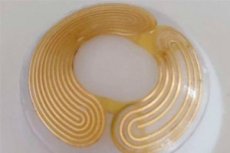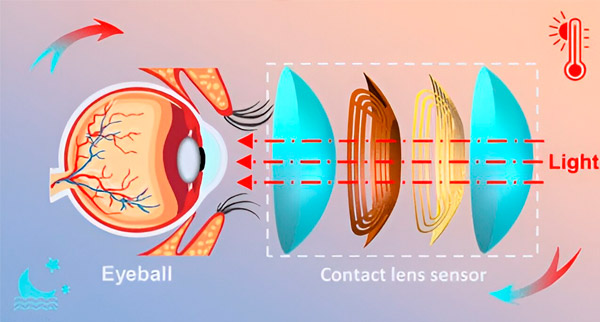
大多数早期青光眼患者并不知道自己患有此病,但早期治疗对于减少视力损失至关重要。检测眼压轻微升高有助于医生诊断青光眼,但定期监测眼压却很困难,尤其是在眼部暴露于广泛温度变化的情况下。现在,美国化学学会应用材料与界面研究所 (ACS Applied Materials & Interfaces) 的研究人员报告了一种“智能”隐形眼镜的原型,它可以在任何温度下准确测量眼压。
根据美国疾病控制与预防中心 (CDC) 的数据,全球约有 8000 万人患有青光眼,这是一种损害视神经并导致视力丧失的疾病。医生在眼科检查中使用“眼压计测试”来测量眼内压力。轻微的眼压升高,这种由角膜周围积液引起的几乎难以察觉的症状,可以确诊为青光眼。
研究人员正在测试一些能够持续且更舒适地检测这些微小压力波动的方法,例如将信号传输到特殊眼镜的隐形眼镜。然而,温度变化(例如在寒冷的环境中外出)可能会影响镜片的测量结果。因此,研究员肖登宝和他的同事着手研发一种能够在各种温度范围内精确测量并以无线方式传输实时眼压数据的隐形眼镜。

肖的团队最初开发了两个微型螺旋电路,每个电路都具有独特的固有振动模式,这些模式会在拉伸时发生变化,例如随着压力和眼球直径的变化。为了制造压力感应隐形眼镜,研究人员将这些微型电路夹在聚二甲基硅氧烷(一种标准的隐形眼镜材料)层之间。
然后,他们利用连接到计算机并放置在镜片旁边的线圈读取嵌入式电路的振动模式。传输信号不受模拟眼球运动、长时间暴露于潮湿环境(模拟眼内潮湿状态)以及日常佩戴的影响。
在实验室测试中,研究人员将新型镜片放置在三个猪眼样本上,监测眼压和眼温。这些镜片监测并无线传输了10至50摄氏度温度范围内的压力数据。当仅使用镜片中的一个电路计算压力时,结果误差高达87%。然而,当使用两个电路的信息时,压力读数的误差仅为7%,因为电路组合消除了与温度相关的误差。
研究人员表示,他们的双芯片智能镜片设计有可能准确地检测和监测早期青光眼,即使在很宽的温度范围内也是如此。

